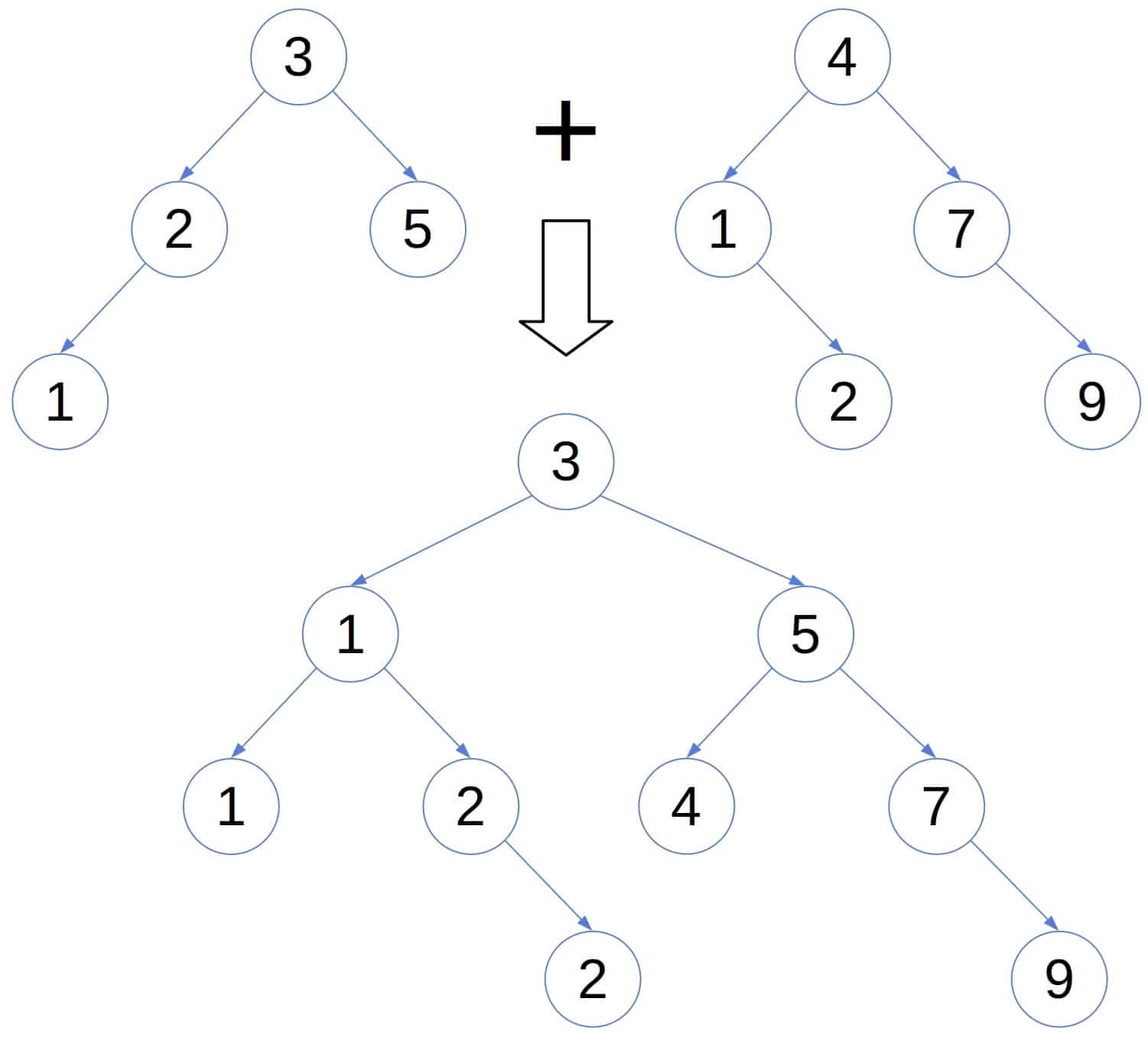1. 概述
二叉搜索树(Binary Search Tree,简称 BST) 是一种非常基础的数据结构,属于二叉树的一种。它的核心特性是:任意节点的左子节点值小于该节点,右子节点值大于该节点。
在本教程中,我们将学习两种合并两个 BST 的算法,并分析它们的时间与空间复杂度(Big O 表示法)。复杂度分析对于评估算法性能非常重要,它能帮助我们了解算法在时间和空间上的开销。
下图展示了两个 BST(BST1 和 BST2)合并后的结果。合并后的 BST 包含了 BST1 和 BST2 中的所有元素,并保持 BST 的特性:

2. 合并、排序、重建
该算法的核心思想是:
- 将两个 BST 的元素分别提取到数组中;
- 合并这两个数组并进行排序;
- 使用排序后的数组重建一个新的 BST。
✅ 算法步骤:
- 提取元素:分别对 BST1 和 BST2 进行中序遍历,将元素存储到两个数组中;
- 合并排序:将两个数组合并成一个,并使用排序算法(如快速排序、归并排序等)进行排序;
- 重建 BST:使用排序后的数组构建一个新的平衡 BST。
⏱️ 时间复杂度分析:
- 提取元素:
O(n1 + n2),其中n1和n2是两个 BST 的节点数。 - 排序:
O(n log n),如果使用归并排序或快速排序。 - 重建 BST:
O(n),其中n = n1 + n2。
📦 空间复杂度:
O(n),因为需要额外的数组来存储所有节点。
✅ Java 示例代码:
public class MergeBSTBySorting {
public static TreeNode mergeBSTs(TreeNode root1, TreeNode root2) {
List<Integer> list1 = new ArrayList<>();
List<Integer> list2 = new ArrayList<>();
// Step 1: 中序遍历提取元素
inOrderTraversal(root1, list1);
inOrderTraversal(root2, list2);
// Step 2: 合并并排序
List<Integer> merged = new ArrayList<>();
merged.addAll(list1);
merged.addAll(list2);
Collections.sort(merged);
// Step 3: 构建新 BST
return buildBST(merged, 0, merged.size() - 1);
}
private static void inOrderTraversal(TreeNode root, List<Integer> list) {
if (root == null) return;
inOrderTraversal(root.left, list);
list.add(root.val);
inOrderTraversal(root.right, list);
}
private static TreeNode buildBST(List<Integer> list, int start, int end) {
if (start > end) return null;
int mid = (start + end) / 2;
TreeNode node = new TreeNode(list.get(mid));
node.left = buildBST(list, start, mid - 1);
node.right = buildBST(list, mid + 1, end);
return node;
}
}
⚠️ 踩坑提醒:
- 如果使用冒泡排序等低效排序算法,复杂度会退化到
O(n²),不推荐。 - 此方法适用于节点数量不大或需要构建平衡 BST 的场景。
3. 遍历、归并、重建
该算法的核心思想是利用两个 BST 的中序遍历结果是有序数组的特性,像归并排序一样合并两个有序数组,然后重建 BST。
✅ 算法步骤:
- 对两个 BST 分别进行中序遍历,得到两个有序数组;
- 归并这两个有序数组为一个有序数组;
- 使用该有序数组构建一个新的 BST。
⏱️ 时间复杂度分析:
- 中序遍历:
O(n1 + n2) - 归并排序:
O(n1 + n2) - 重建 BST:
O(n) - 总体时间复杂度:
O(n1 + n2)
📦 空间复杂度:
O(n1 + n2),需要两个数组存储遍历结果。
✅ Java 示例代码:
public class MergeBSTByMergingInOrder {
public static TreeNode mergeBSTs(TreeNode root1, TreeNode root2) {
List<Integer> list1 = new ArrayList<>();
List<Integer> list2 = new ArrayList<>();
// Step 1: 中序遍历提取元素
inOrderTraversal(root1, list1);
inOrderTraversal(root2, list2);
// Step 2: 归并两个有序数组
List<Integer> merged = new ArrayList<>();
int i = 0, j = 0;
while (i < list1.size() && j < list2.size()) {
if (list1.get(i) < list2.get(j)) {
merged.add(list1.get(i++));
} else {
merged.add(list2.get(j++));
}
}
while (i < list1.size()) merged.add(list1.get(i++));
while (j < list2.size()) merged.add(list2.get(j++));
// Step 3: 构建新 BST
return buildBST(merged, 0, merged.size() - 1);
}
private static void inOrderTraversal(TreeNode root, List<Integer> list) {
if (root == null) return;
inOrderTraversal(root.left, list);
list.add(root.val);
inOrderTraversal(root.right, list);
}
private static TreeNode buildBST(List<Integer> list, int start, int end) {
if (start > end) return null;
int mid = (start + end) / 2;
TreeNode node = new TreeNode(list.get(mid));
node.left = buildBST(list, start, mid - 1);
node.right = buildBST(list, mid + 1, end);
return node;
}
}
⚠️ 踩坑提醒:
- 这个方法比“先合并后排序”更高效,因为利用了 BST 的中序遍历是有序数组这一特性;
- 如果你希望合并后的 BST 也是平衡的,可以考虑此方法;
- 不建议手动实现归并逻辑时写错边界条件,容易越界。
4. 总结
| 方法 | 时间复杂度 | 空间复杂度 | 特点 |
|---|---|---|---|
| 合并、排序、重建 | O(n log n) |
O(n) |
实现简单,适合节点不多的场景 |
| 遍历、归并、重建 | O(n) |
O(n) |
更高效,推荐使用,适合大规模数据 |
✅ 总结建议:
- 若对性能要求较高,推荐使用“遍历、归并、重建”方案;
- 若节点数量不多,且对平衡性无要求,可以使用“合并、排序、重建”;
- 合并 BST 的关键在于利用中序遍历的有序性,这是 BST 的核心特性之一。